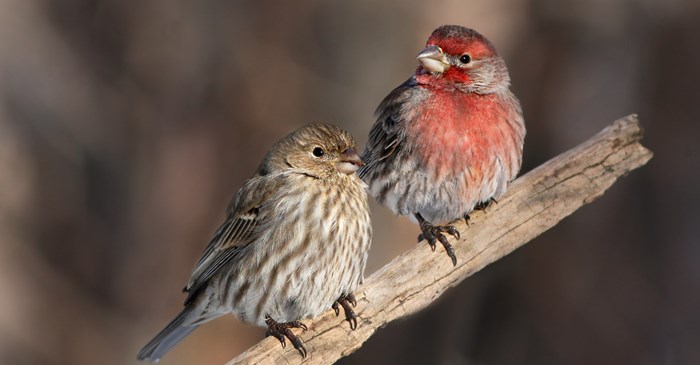The House Finch is one that delights backyard birders with their social antics and the sweetness of their song. Beyond the feeders they readily visit, here are three fun things to know about the House Finch.
Their diet colors their feathers
In addition to his sweet, somewhat buzzy song, the male House Finch is known for the wash of red on his head, face and breast that transitions to brown-streaked feathers. Compare the birds in a flock, and you may notice differences in shades of red between individual males. They may sport orangey-red or even yellow feathers. How does this happen? Like other birds with red, orange or yellow plumage, it’s all diet dependent. Some of the seeds and plants they eat contain pigments called carotenoids. The more carotenoids they eat, the redder their feathers get. And the redder the feathers, the more likely they are to attract a female. Males are brownish overall with red forehead, throat and breast. They also have thick brown streaks on their flank areas. Females in contrast, will be brownish-gray with overall streaks and a plain face.
House Finches are western transplants
What gives the House Finch its name? It's for the simple fact that where there are houses, you’ll find these finches. They're at home in cities and suburbs, and in rural areas, they'll gravitate to barns and houses. Though you'll find them throughout the East Coast and the south, House Finches are actually natives to the Western U.S. What happened? Back in the 1940s, House Finches were marketed in New York, sold in cages as “Hollywood finches.” Once officials caught wind of this scheme, which was illegal under the Migratory Bird Treaty Act, pet shop owners set them free in Long Island to avoid fines. Since then, the so-called eastern branch of the House Finch family expanded and flourished.
House Finches stay away from creepy crawlies
The House Finch diet is almost entirely plant-based, subsisting of buds, weeds and seeds. Unlike their fellow vegetarians, though, they don’t feed worms and insects to their nestlings. These birds often travel in flocks, foraging for food, sometimes in large groups. Once these social birds discover your feeder, you may find yourself playing host to the entire charm of House Finches!
Keep the House Finches fed and singing through the fall and winter by setting out a high-quality, handcrafted blend chock-full of nutritious seeds and nuts, such as Lyric Supreme Wild Bird Mix.
